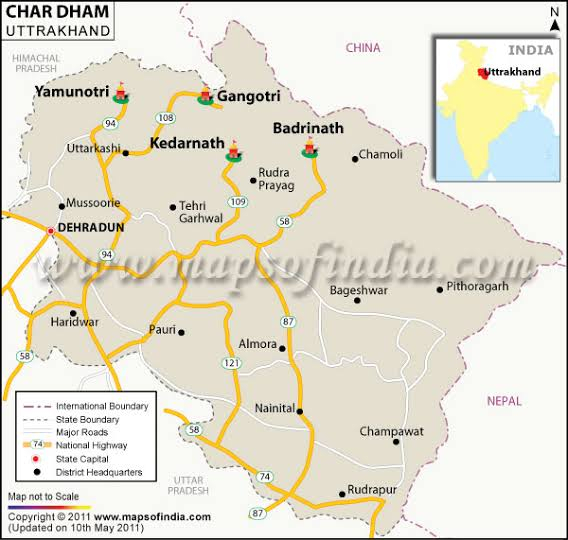Focus: GS-III Environment and Ecology, Industry and Infrastructure
Why in news?
In a review meeting of the Chardham Project via Video Conferencing, Union Environment Minister informed that the Zonal Master Plan (ZMP) has been accorded approval by the Ministry of Environment, Forest and Climate Change (MoEF&CC).
Details
- The Bhagirathi Eco-Sensitive Zone notification was issued by the Ministry of Environment, Forest and Climate Change (MoEF&CC) keeping in view the requirements of the local people without affecting their rights and privileges and also ensuring eco-friendly development for their livelihood security.
- The Bhagirathi Eco-Sensitive Zone notification mandated the State Government of Uttarakhand to prepare ZMP to be implemented under the supervision of the Monitoring Committee.
- The ZMP is based on watershed approach and includes governance in the area of forest and wildlife, watershed management, irrigation, energy, tourism, public health and sanitation, road infrastructure, etc.
- The approval of ZMP will give a boost to conservation and ecology of the area and also to undertake developmental activities as permitted under ZMP.
- The approval of ZMP will give a boost to conservation and ecology of the area and also to undertake developmental activities as permitted under ZMP.
- The approval will also pave way for faster execution of the Chaar Dhaam Project.
What are Eco-Sensitive Zones (ESZs)?
- Eco-Sensitive Zones or Ecologically Fragile Areas are areas within 10 kms around Protected Areas, National Parks and Wildlife Sanctuaries.
- ESZs are notified by MoEFCC, Government of India under Environment Protection Act 1986.
- In case of places with sensitive corridors, connectivity and ecologically important patches, crucial for landscape linkage, even area beyond 10 km width can also be included in the eco-sensitive zone.
- The basic aim is to regulate certain activities around National Parks and Wildlife Sanctuaries so as to minimise the negative impacts of such activities on the fragile ecosystem encompassing the protected areas.
Activities Allowed in ESZs
- Prohibited activities: Commercial mining, saw mills, industries causing pollution (air, water, soil, noise etc), establishment of major hydroelectric projects (HEP), commercial use of wood, Tourism activities like hot-air balloons over the National Park, discharge of effluents or any solid waste or production of hazardous substances.
- Regulated activities: Felling of trees, establishment of hotels and resorts, commercial use of natural water, erection of electrical cables, drastic change of agriculture system, e.g. adoption of heavy technology, pesticides etc, widening of roads.
- Permitted activities: Ongoing agricultural or horticultural practices, rainwater harvesting, organic farming, use of renewable energy sources, adoption of green technology for all activities.
Chardham Project

- Char Dham Expressway National Highway is a proposed two-lane (in each direction) express National Highway in the state of Uttarakhand.
- Under the prestigious ‘Char Dham’ road project costing about ₹12,000 crore, BRO is constructing 250 km of national highway leading to the holy Hindu shrines of Gangotri and Badrinath.
The proposed highway will complement the under-development Char Dham Railway by connecting the four holy places in Uttarakhand which are:
- Badrinath
- Kedarnath
- Gangotri
- Yamunotri
The roads will be widened from 12m to 24m and the project will involve construction of tunnels, bypasses, bridges, subways and viaducts.
All of these four sites are devoted to a specific deity. Gangotri is dedicated to the Goddess Ganga, Yamunotri is dedicated to the Goddess Yamuna, Kedarnath is dedicated to Lord Shiva and is one of the 12 jyotirlingas and Badrinath, is dedicated to Lord Vishnu.




